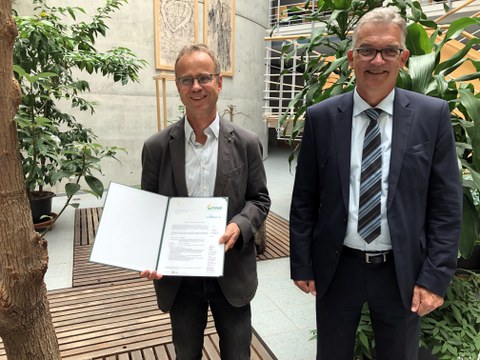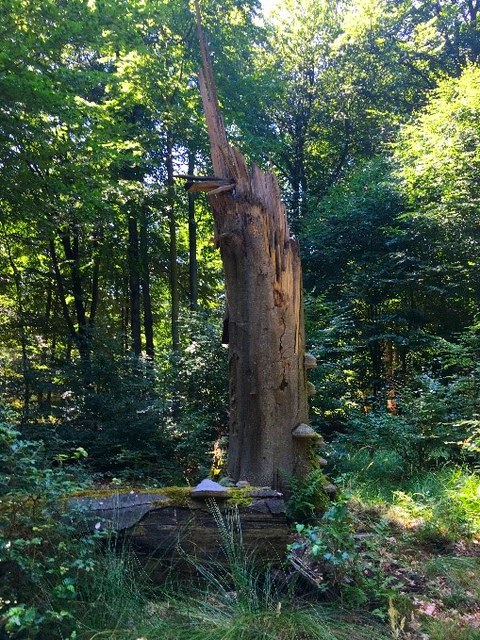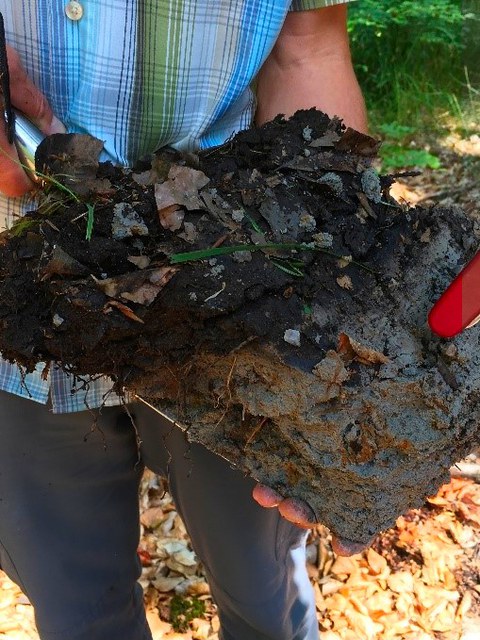Jul 29, 2021
Climate Change - How much carbon can natural forests store?

Uwe Feiler, Parliamentary State Secretary at the BMEL (r.) presented the funding decision for the BENEATH project to Prof. Karsten Kalbitz from the TU Dresden.
Among the numerous services that forest ecosystems provide for humans and the environment, the ability to store large amounts of carbon (C) is among the most crucial ones. This becomes even more important as a further rapid rise in the CO2 concentration in the atmosphere must be counteracted on a sustainable basis. It is not only about the trees, bushes, herbs and mosses that are accessible to the eye of the forest visitor. The hidden "underground forest" with its roots, soil organisms and soil organic organic matter, the humus, is of particular importance. A team of scientists from TU Dresden is investigating the question: How does climate change affect the C-storage capacity of forest soils? The team is funded by the Forest Climate Fund. On July 22, 2021, Uwe Feiler, State Secretary in the Federal Ministry of Food and Agriculture, handed over the funding decision in the amount of almost 1.8 million euros to the project coordinator Prof. Dr. Karsten Kalbitz.

Standing or lying coarse woody debris is an important component in the carbon cycle of forests. Particularly in forests managed close to nature, there is a lot of it.
Dresden / Tharandt. The mechanisms and conditions responsible for carbon storage in forests are now being tracked down by a new joint research program at the Department of Forest Sciences at the TU Dresden in Tharandt. The long-term project BENEATH is funded initially for four years from federal funds within the framework of the Forest Climate Fund with a sum of about 1.8 million euros. With sophisticated measurement technology, the C fluxes are recorded continuously over the course of the year by a team of soil and water experts as well as botanists. Weather conditions are of particular importance: according to climate forecasts, extreme events - especially extreme dry periods in rapid alternation with humid conditions - will become more and more common in the future. Thus, the soil water balance is increasingly becoming the decisive control variable for tree growth. But the chemical and biological reactions above and below the soil surface also depend heavily on the availability of water and the small-scale temperature conditions. How much carbon can be stored in the forest ecosystem in the long term also depends on the intensity of forest management. If less wood biomass is removed due to near-natural forest management, the resulting increased proportion of “dead wood” becomes more important as an input component for the ecosystem C cycle. At the same time, deadwood is also important for the biodiversity of the organisms involved in C turnover - from fungi and bacteria to insects and birds such as the woodpecker.

Considerable amounts of carbon can be stored in the soil, the darker the more carbon.
Against this background, in the "Kossa Beech Forest Area" in the “Dübener Heide” (Northwest Saxony) a study is being carried out to determine how spatial-temporal patterns in soil moisture influence the above- and belowground carbon storage. The spokesperson of the research initiative, Prof. Karsten Kalbitz, explains: "The interactions between available soil water, dead wood, living trees with their root systems and carbon storage in the soil have so far been little studied under strongly changing environmental conditions". Natural gradients in the local water balance are used in the project to reveal the consequences of climate change-related changes in the soil moisture regime on the carbon storage of the beech forests and to derive scenarios for future development. For this purpose, long-term integrated monitoring of important ecosystem parameters will be combined with field experiments, state-of-the-art analysis methods in the laboratory and innovative modelling approaches. The participating scientists hope to gain important insights into the complex functions of near-natural forest ecosystems. These findings can later be incorporated into practical silviculture. The results also help to improve the predictive power of regional and global climate models.
Contact:
Prof. Dr. Karsten Kalbitz
Tel. +49 351 463-31379
Further information
Waldklimafond
